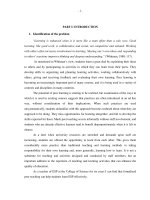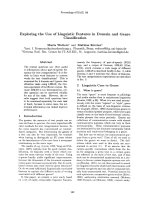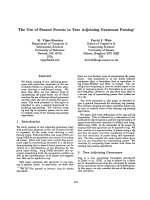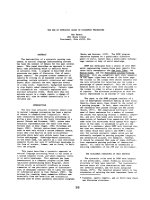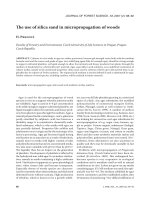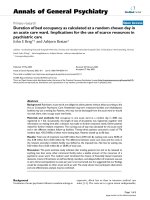The use of hypothesis-testing statistics in clinical trials
Bạn đang xem bản rút gọn của tài liệu. Xem và tải ngay bản đầy đủ của tài liệu tại đây (2.09 MB, 16 trang )
Chapter
8
The use of hypothesis-testing
statistics in clinical trials
It has been rightly observed that while it does not take a great mind to make simple
things complicated, it takes a very great mind to make complicated things simple.
Austin Bradford Hill (Hill, 1962; p. 8)
How to design clinical trials
My teachers taught me that when you design a study, the rst step is how you plan to ana-
lyze it, or how you plan to present the results. One of my teachers even suggested that one
shouldwriteuptheresearchpaperthatonewouldimagineastudywouldproduce–before
conducting the study. Written of course without the actual numbers, this fantasy exercise has
the advantage of pointing out, before a study is designed, exactly what kind of analyses, num-
bers, and questions need to be answered. e worst thing is to design and complete a study,
analyze the data, begin to write the paper, and then realize that an important piece of data
was never collected!
Clinical trials: how many questions can we answer?
e clinical trial is how we experiment with human beings. We no longer are dealing with
Fisher’s dierent strains of seeds, strewn on diering kinds of soil in a randomized trial. We
now have human beings, not seeds, and the resulting clinical trial is how we apply statistical
methods of randomization to medical experimentation.
Perhaps the most important feature of clinical trials is that they are designed to answer
a single question, but we humans force them to answer hundreds. is is the source of both
their power and their debility.
e value of clinical trials comes from this ability to denitively (or as denitively as
is possible in this inductive world) answer a single question: does aspirin prevent heart
attacks? Does streptomycin cure pneumonia? We want to know these answers. And each
single answer, with nothing further said, is worth tons of gold to the health of humankind.
Such a single question is called the primary outcome of a clinical trial.
But we researchers and doctors and patients want to know more. Not only do we want to
know if aspirin prevents heart attacks, but did it also lead to lower death rates? Did it pre-
vent stroke too perhaps? What kinds of side eects did it cause? Did it cause gastrointestinal
bleeding? If so, how many died from such bleeding?
So we seem forced to ask many questions of our clinical trials, partly because we want to
knowaboutsideeects,butpartlyjustoutofourowncuriosity:wewanttoknowasmuch
as possible about the eects of a drug on a range of possible benets.
Sometimes we ask many questions for economic reasons. Clinical trials are expensive;
whether a pharmaceutical company or the federal government is paying for it, in either case
Section 3: Chance
shareholders or taxpayers will want to get as much as possible out of their investment. You
spent $10 million to answer one question? Could you not answer 5 more? Perhaps if you
answered 50 questions, the investment would seem even more successful. is may be how
it is in business, but in science, the more questions you seek to answer, the fewer you answer
well.
False positives and false negatives
e clinical trial is designed primarily to remove the problem of confounding bias, that is,
to give us valid data. It removes the problem of bias, but then is faced with the problem of
chance.
Chancecanleadtofalseresultsintwodirections,falsepositivesandfalsenegatives.
False positives occur when the p-value is abused. If too many p-values are assessed, then
the actual values will be incorrect. An ination of chance error occurs, and one will be likely
toobservemanychancepositivendings.
False negatives occur when the p-value is abnormally high due to excessive variability in
the data. What this means is that there are not enough data points – not enough patients –
to limit the variation in the results. e higher the variation, the higher the p-value. us,
if a study is too small, it will be highly variable in its data, i.e., it will lack precision, and the
p-value will be inated. us, the eect will be deemed statistically unworthy.
False positive error is also called type I or α error;falsenegativeiscalledtype II or β error.
e ability to avoid false negative results, by having limited variability and higher precision
of the data, is also called statistical power.
To avoid both of these kinds of errors, the clinical trial needs to establish a single, primary
outcome. By essentially putting all its eggs in one basket, the trial is stating that the p-value
for that single analysis should be taken at face value; it will not be distorted by multiple com-
parisons. Further, by having a primary outcome, the clinical trial can be designed such that
a large enough sample size is calculated to limit the variability of the data, improve the pre-
cision of the study, and ensure a reasonable likelihood of statistical signicance if a certain
eect size is obtained.
Aclinicaltrialrisesandfallsoncarefulselectionofaprimaryoutcome,andcarefuldesign
of the study and sample size so as to assess the primary outcome.
The primary outcome
e primary outcome is usually some kind of measurement, such as points on a depression
rating scale. is measurement can be dened in various ways; for example, it can reect the
actual change in points on a depression rating scale with drug versus placebo; or it can reect
the percentage of responders in drug versus placebo groups (usually dening response as
50% or more improvement in depression rating scale score). In general, the rst approach is
taken: the actual change in points is compared in the two groups. is is a continuous scale of
measurement (1,2,3,4 points ...) not a categorical scale (responders versus non-responders),
which is a strength. Statistically, continuous measurements provide more data, less variabil-
ity, and thus more statistical power, thereby enhancing the possibility of a lower p-value. is
is the main reason why most primary outcomes in psychiatry and psychology involve con-
tinuous rating scale measures.
On the other hand, categorical assessments are oen intuitively more understandable by
clinicians. us, it is typical for a clinical treatment study in psychiatry to be designed mainly
46
Chapter 8: Clinical trials
to describe a change in depressive symptoms as a number (a continuous change), while also
to report the percentage of responders as a second outcome. While both of these outcomes
ow one from the other, it is important for researchers to make a choice; they cannot both
equally be primary outcomes. A primary outcome is one outcome, and only one outcome.
e other is a secondary outcome.
Secondary outcomes
It is natural to want to answer more than one question in a clinical trial. But one needs to
be clear which questions are secondary ones, and they need to be distinguished from the
primary question. eir results, whether positive or negative, need to be equally interpreted
more cautiously than in the case of the primary outcome.
Yet it is not uncommon to see research studies where the primary outcome, such as a con-
tinuous change in a depression rating score, may not show a statistically signicant benet,
while a secondary outcome, such as categorical response rate, may do so. Researchers then
may be tempted to emphasize the categorical response throughout the paper and abstract.
For instance, in a study of risperidone versus placebo added to an antidepressant for
treatment-refractory unipolar depression (n = 97) (Keitner et al., 1996), the published
abstract reads as follows: “Subjects in both treatment groups improved signicantly over
time. e odds of remitting were signicantly better for patients in the risperidone vs. placebo
arm (OR = 3.33, p = .011). At the end of 4 weeks of treatment 52% of the risperidone aug-
mentation group remitted (MADRS10) compared to 24% of the placebo augmentation group
(CMH(1) = 6.48, p = .011), but the two groups were converging.” Presumably, the continu-
ous mood rating scale scores, which are typically the primary outcome in such randomized
clinical trials (RCTs), did not dier between drug and placebo. e abstract is ambiguous. As
in this case, oen one has trouble identifying any clear statement about which results were
the primary outcome and which were secondary outcomes. Without such clarity, one gets the
unfortunate result that studies which are negative (on their primary outcomes) are published
so as to appear positive (by emphasizing the secondary outcomes).
Not only can secondary outcomes be falsely positive, they can just as commonly be
falsely negative. In fact, secondary analyses should be seen as inherently underpowered. An
analysis found that, aer the single primary outcome, the sample size needed to be about
20% larger for a single secondary outcome, and 30% larger for two secondary outcomes
(Leon, 2004).
Post-hoc analyses and subgroup eects
We now reach the vexed problem of subgroup eects. is is the place where, perhaps most
directly, statisticians and clinicians have opposite goals. A statistician wants to get results that
are as valid as possible and as far removed from chance as possible. is requires isolating
one’s research question more and more cleanly, such that all other factors can be controlled,
and the research question then answered directly. A clinician wants to treat the individual
patient, a patient who usually has multiple characteristics (each of us belongs to a certain race,
has a certain gender, an age, a social class, a specic history of medical symptoms, and so on),
and where the clinical matter at question occurs in the context of those multiple characteris-
tics. e statistician produces an answer for the average patient on an isolated question; the
clinician wants an answer for a specic patient with multiple relevant features that inuence
the clinical question. For the statistician, the question might be: Is antidepressant X better
47
Section 3: Chance
Table 8.1. Inflation of false positive probabilities with outcomes tested
Number of hypotheses tested Type I error tested at 0.05 level
10.05
2 0.0975
30.14
50.23
10 0.40
15 0.54
20 0.64
30 0.785
50 0.92
75 0.979
100 0.999
With every hypothesis test at alpha level of 0.05, there is a 1/20 chance the null hypothesis will be rejected by
chance. However, to get the probability at least one test would pass if one examines two hypotheses, you cannot
multiply 1/20 × 1/20. Instead, one has to multiply the chance the null
would not
be rejected – that is 19/20 ×
19/20 (a form of the binomial distribution). Extending this, one can see that the key term would then be 19 n/20 n
with n being the number of comparisons, and to get the chance of a Type I error (the null is falsely rejected) the
equation would be 1 − 19 n/20 n.
With thanks to Eric G. Smith, MD, MPH (Personal Communication 2008).
than placebo in the average patient? For the clinician, the question might be: Is antidepres-
sant X better than placebo in this specic patient who is African-American, male, 90 years
old, with comorbid liver disease? Or, alternatively, is antidepressant X better than placebo
in this specic patient who is white, female, 20 years old, with comorbid substance abuse?
Neither of them is the “average” patient, if thereissuchathing:onewouldhavetoimagine
a middle-aged person with multiple racial complexity and partial comorbidities of varying
kinds.
Inotherwords,iftheprimaryoutcomeofaclinicaltrialgivesusthe“average”resultin
an “average” patient, how can we apply those results to specic patients? e most common
approach, for better and for worse, is to conduct subgroup analyses. In the example above:
we might look at the antidepressant response in men versus women, whites versus blacks, old
versus young, and so on. Unfortunately, these analyses are usually conducted with p-values,
which leads to both false positive and false negative risks, as noted above.
The ination of p-values
To briey reiterate, because this matter is worth repeating over and over, the false positive
risk is that repeated analyses are a misapplication of the size of the p-value. A p-value of 0.05
means that with one analysis one has a 5% likelihood that the observed result occurred by
chance. If ten analyses are conducted, one of which produces a p-value of 0.05, that does
NOT mean that the likelihood of that result by chance is 5%; rather it is near 40%. at is the
whole concept of a p-value: if analyses are repeated enough, false positive chance ndings will
occur at a certain frequency, as shown in Table 8.1 in computer simulation by my colleague
Eric Smith (personal communication 2008).
48
Chapter 8: Clinical trials
Suppose we are willing to accept a p-value of 0.05, meaning that assuming the null
hypothesis (NH) is true, the observed dierence is likely to occur by chance 5% of the time.
e chance of inaccurately accepting a positive nding (rejecting the NH) would be 5% for
one comparison, about 10% for two comparisons, 23% for ve comparisons, and 40% for
tencomparisons.ismeansthatifinanRCT,theprimaryanalysisisnegative,butone
of four secondary analyses is positive with p = 0.05, then that p-value actually reects a
23% false positive chance nding, not a 5% false positive chance nding. And we would not
accept that higher chance likelihood. Yet clinicians and researchers oen do not consider
this issue. One option would be to do a correction for multiple comparisons, such as the
Bonferronicorrection,whichwouldrequirethatthep-valuebemaintainedat0.05overall
by dividing it by the number of comparisons made. For ve comparisons, the acceptable p-
value would be 0.05/5, or 0.01. e other approach would be to simply accept the nding,
but to give less and less interpretive weight to a positive result as more and more analyses are
performed.
is is the main rationale why, when an RCT is designed, researchers should choose
one or a few primary outcome measures for which the study should be properly powered
(alevelof0.80or0.90[power= 1 − type II error] is a standard convention). Usually there
is a main ecacy outcome measure, with one or two secondary ecacy or side eect out-
come measures. An ecacy eect or side eect to be tested can be established either a pri-
ori (before the study, which is always the case for primary and secondary outcomes) or
post hoc (aer the fact, which should be viewed as exploratory, not conrmatory, of any
hypothesis).
Clinical example: olanzapine prophylaxis of bipolar disorder
In an RCT of olanzapine added to standard mood stabilizers (divalproex or lithium) for
prevention of mood episodes in bipolar disorder (Tohen et al., 2004), I have often seen the
results presented at conferences as positive, with the combined group of olanzapine plus
mood stabilizer preventing relapse better than mood stabilizer alone. But the positive
outcome was secondary, not primary. The protocol was designed such that all patients who
responded to olanzapine plus divalproex or lithium initially for acute mania would then be
randomized to staying on the combination (olanzapine plus mood stabilizer) versus mood
stabilizer alone (placebo plus mood stabilizer). The primary outcome was time to a new mood
episode (meeting full DSM-IV criteria for mania or depression) in those who responded to
olanzapine plus mood stabilizer initially for acute mania (with response defined as > 50%
improvement in mania symptom rating scale scores). On this outcome, there was no
difference between continuation of olanzapine plus the mood stabilizer or switch to placebo
plus mood stabilizer. The primary outcome of this study was negative. Among a number of
secondary outcomes, one was positive, defined as time to symptomatic worsening (the
recurrence of an increase of manic symptoms or new depressive symptoms, not necessarily
full manic or depressive episodes) among those who had initially achieved full remission with
olanzapine plus mood stabilizer for acute mania (defined as mania symptom rating scores
below 7, i.e., almost no symptoms). On this outcome, the olanzapine plus mood stabilizer
combination group had a longer time to symptomatic recurrence than the mood stabilizer
alone group (p = 0.023). This p-value does not accurately represent the true chance of a
positive finding on this outcome. The published paper does not clearly state how many
secondary analyses were conducted a priori, but assuming that one primary analysis was
conducted, and two secondary analyses, Table 8.1 indicates that one p-value of 0.05 would be
49
Section 3: Chance
equivalent to a true positive likelihood of 0.14. Thus, the apparent p-value of 0.023 likely
represents a true likelihood above the 0.05 usual cutoff for statistical significance. In sum, the
positive secondary outcome should be given less weight than the primary outcome because
of inflated false positive findings with multiple comparisons.
The astrology of subgroup analysis
One cannot leave this topic without describing a classic study about the false positive risks of
subgroup analysis, an analysis which correlated astrological signs with cardiovascular out-
comes. In this famous report, the investigators for a well-known study of anti-arrhythmic
drugs (ISIS-2) decided to do a subgroup analysis of outcome by astrological sign (Sleight,
2000). (e title of the paper was: “Subgroup analyses in clinical trials: fun to look at – but
don’t believe them!”.) e trial was huge, involving about 17 000 patients, and thus some
chance positive ndings would be expected with enough analyses in such a large sample.
e primary outcome of the study was a comparison of aspirin versus streptokinase for pre-
vention of myocardial infarction, with a nding in favor of aspirin. In subgroup analyses by
astrological sign, the authors found that patients born under Gemini or Libra experienced “a
slightly adverse eect of aspirin on mortality (9% increase, standard deviation [SD] 13; NS),
while for patients born under all other astrological signs there was a striking benecial eect
(28% reduction, SD 5; p < 0.00001).”
Either there is something to astrology, or subgroup analyses should be viewed cautiously.
It will not do to think only of positive subgroup results as inherently faulty, however. e
false negative risk is just as important; p-values above 0.05 are oen called “no dierence,”
when in fact one group can be twice as frequent or larger than the other; yet if the overall
frequencyoftheeventislow(asitoeniswithsideeects,seebelow),thenthestatistical
power of the subgroup analyses will be limited and p-values will be above 0.05. inking of
how sample size aects statistical power, note that with subgroup analyses samples are being
chopped up into smaller groups, and thus statistical power declines notably.
So subgroup analyses are both falsely positive and falsely negative, and yet clinicians will
want to ask those questions. Some statisticians recommend holding the line, and refusing to
do them. Unfortunately, patients are living people who demand the best answers we can give,
even if they are not nearly certain beyond chance likelihood. So let us examine some of the
ways statisticians have suggested that the risks of subgroup analyses can be mitigated.
Legitimizing subgroup analyses
Two common approaches follow :
1. Divide the p-value by the number of analyses; this will provide the new level of statis-
tical signicance. Called the “Bonferroni correction,” the idea is that if ten analyses are
conducted, then the standard for signicance for any single analysis would be 0.05/10 =
0.005. e higher threshold of 0.5%, rather than 5%, would be used to call a result unlikely
to have happened by chance. is approach draws the p-value noose as tightly as possible,
so that what passes through is likely true, but much that is true fails to pass through. Some
more liberal alternatives (such as the Tukey test) exist, but all such approaches are guesses
about levels of signicance, which can be either too conservative or too liberal.
2. Choose the subgroup analyses before the study, a priori, rather than post hoc. e problem
with post-hoc analyses is that, almost always, researchers do not report how many such
50


